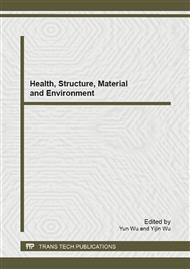[1]
J. Chowdhury. Confidence interval for design floods with estimated skew coefficient. Journal of Hydraulic Engineering, Vol. 117 (1991), pp.811-831.
DOI: 10.1061/(asce)0733-9429(1991)117:7(811)
Google Scholar
[2]
F. Francés. Flood frequency analysis using systematic and non-systematic information. Systematic, palaeoflood and historical data for the improvement of flood risk estimation: Methodological guidelines. CSIC-Centro de Ciencias Medioambientales, Madrid, Vol. 31 (2004).
Google Scholar
[3]
S. Coles, and L. Pericchi, Anticipating catastrophes through extreme value modelling. Journal of the Royal Statistical Society: Series C (Applied Statistics), Vol. 52 (2003), pp.405-416.
DOI: 10.1111/1467-9876.00413
Google Scholar
[4]
D.S. Reis, and J.R. Stedinger, Bayesian MCMC flood frequency analysis with historical information. Journal of hydrology, Vol. 313 (2005), pp.97-116.
DOI: 10.1016/j.jhydrol.2005.02.028
Google Scholar
[5]
E. Gaume. Bayesian MCMC approach to regional flood frequency analyses involving extraordinary flood events at ungauged sites. Journal of hydrology, Vol. 394 (2010), pp.101-117.
DOI: 10.1016/j.jhydrol.2010.01.008
Google Scholar
[6]
E. Parent and J. Bernier. Bayesian POT modeling for historical data. Journal of hydrology, Vol. 274 (2003), pp.95-108.
DOI: 10.1016/s0022-1694(02)00396-7
Google Scholar
[7]
M. Ribatet. A regional Bayesian POT model for flood frequency analysis. Stochastic Environmental Research and Risk Assessment, Vol. 21 (2007), pp.327-339.
DOI: 10.1007/s00477-006-0068-z
Google Scholar
[8]
A.F. Jenkinson. The frequency distribution of the annual maximum (or minimum) values of meteorological elements. Quarterly Journal of the Royal Meteorological Society, Vol. 81 (1995), pp.158-171.
DOI: 10.1002/qj.49708134804
Google Scholar
[9]
J. Hosking and J.R. Wallis, Regional frequency analysis: an approach based on L-moments. Cambridge (Cambridge University Press. 1997).
Google Scholar
[10]
H.L. Harter. A new table of percentage points of the Pearson Type III distribution. Technometrics, Vol. 11 (1969), pp.177-187.
DOI: 10.1080/00401706.1969.10490669
Google Scholar
[11]
J.R. Hosking. L-moments: analysis and estimation of distributions using linear combinations of order statistics. Journal of the Royal Statistical Society. Series B (Methodological), Vol. 52 (1990), pp.105-124.
DOI: 10.1111/j.2517-6161.1990.tb01775.x
Google Scholar
[12]
E.F. Wood and I. Rodríguez-Iturbe, Bayesian inference and decision making for extreme hydrologic events. Water Resources Research, 1975, 11(4): pp.533-542.
DOI: 10.1029/wr011i004p00533
Google Scholar
[13]
P.J. Northrop. Likelihood-based approaches to flood frequency estimation. Journal of hydrology, Vol. 292 (2004), pp.96-113.
DOI: 10.1016/j.jhydrol.2003.12.031
Google Scholar
[14]
A. Viglione. nsRFA: Non-supervised Regional Frequency Analysis, R package version 0. 6-9(2009), Available at (http: cran. r-project. org/web/packages/nsRFA).
Google Scholar


